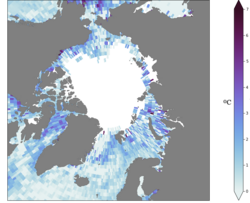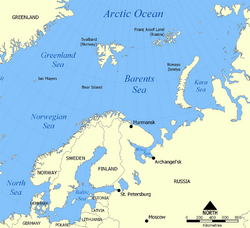Earth:Atlantification of the Arctic

Atlantification is the increasing influence of Atlantic water in the Arctic. Warmer and saltier Atlantic water is extending its reach northward into the Arctic Ocean.[2] The Arctic Ocean is becoming warmer and saltier and sea-ice is disappearing as a result.[3] The process can be seen on the figure on the far right, where the sea surface temperature change in the past 50 years is shown, which is up to 5 degrees in some places. This change in the Arctic climate is most prominent in the Barents Sea, a shallow shelf sea north of Scandinavia, where sea-ice is disappearing faster than in any other Arctic region, impacting the local and global ecosystem.
Structure of the Arctic Ocean
The largest part of the Arctic Ocean has a strong division between ocean layers. At the top is a mixed layer of fresh water with a temperature near the freezing point and a salinity of around 30 psu (practical salinity unit).[4] This water is fed by rivers and melting of sea-ice. Underneath this fresh water is a layer where the salinity increases strongly but the temperature remains low: the cold halocline layer. Below this layer, the temperature increases with depth to above the freezing point. This layer which holds this temperature gradient is called the pycnocline layer.[5] The water underneath is warm and salty, carried in from the Atlantic Ocean by the Atlantic Meridional Overturning Circulation (AMOC). This layer is warmer than the surface layer but because of its salinity it has a higher density than the water above. This means this layer is less buoyant than the surface layer. The cold freshwater therefore floats on top and the halocline across which mixing tends to be weak[6] even under ice free conditions[7] and therefore protects the surface from the heat in the Atlantic water.[8] Under the Atlantic water layer is a deep layer of Arctic bottom water extending to the bottom of the ocean.
Process of Atlantification
The increasing influence of Atlantic water flowing into the Arctic Ocean and the loss of stratification causes the warm Atlantic water to mix with the fresh water at the surface. As can be seen in the figure below, the halocline weakens and therefore heat from the Atlantic water reaches the surface. This warming of the surface water causes a retreat in sea-ice in winter and a total absence of sea-ice in summer.[9] The loss of winter sea-ice means that in summer, the colder layer of freshwater at the surface is less replenished by melting ice, lessening the temperature difference between the layers. Also, a lack of sea-ice increases the influence of wind on the sea surface, mixing the layers further.[10]
Model predictions do not show an upward trend in volume transport into the Arctic from the North Atlantic nor an increase in the temperature of the inflowing water leading some to conclude that the Atlantification of the Arctic is not caused by a process in the Atlantic Ocean but rather by atmospheric forcing in the Arctic region, amplified by sea-ice loss.[11]
However observations show a regime shift from winter sea ice cover to open water in the southern Barents Sea in response to the warming of the inflowing Atlantic water.[9] Observations also reveal the increasing influence of Atlantic water heat further to the east, in the eastern Eurasian Basin, where in recent years the heat flux from the Atlantic water towards the surface has overtaken the atmospheric contribution in this region.[12] Furthermore, an observed weakening of the halocline over this period coincided increasing wind driven upper ocean currents, pointing to increased mixing.[13]

Consequences
At the moment, the largest part of inflowing heat from the Atlantic Ocean is lost to the atmosphere within the Barents Sea. It is expected though, that the temperature in the Barents Sea will increase due to changes in the interaction with the atmosphere. As a result, the water flowing out from the Barents Sea in between Franz Josef Land and Novaya Zemlya (Barents Sea exit) will warm significantly from -0.2[math]\displaystyle{ ^{\circ} }[/math] to 2.2[math]\displaystyle{ ^{\circ} }[/math] C in 2080.[14] This shows that warm Atlantic water will penetrate further into the Arctic Ocean, ultimately extending throughout the Eurasian basin, leading to reduction in sea-ice thickness in this region.
Organisms
Atlantification as part of the climate changing in the Arctic has major consequences for all organisms living there. Due to the warming of Barents Sea, phytoplankton blooms are moving further into the Eurasian Basin each year. Typical species have moved 5 degrees further North compared to 1989.[15] Also, fish communities are moving Northward at the pace of the local climate change, a process called borealization. Some predators that reach areas previously not warm enough change the ecological systems of the Arctic. As a result, Arctic shelf fish are being expelled and retract Northwards as well. For some species, depth might limit their options and this will induce changes in the biodiversity of the Arctic Ocean.[16] This change in marine ecosystem also influences the bird and mammal species living in the Arctic region. Sea birds, seals and whales depend directly on the fish populations. Land mammals like polar bears live on seals and are also strongly dependant on the sea-ice to live on.[17]
Tipping point
There are growing concerns that the Arctic climate might be moving to a so-called tipping point, meaning that if a critical point is reached, the system will settle around a different equilibrium state. In the Arctic this different state could be one with much less or no sea-ice.[18]
References
- ↑ Data provided by Physical Sciences Laboratory, NOAA, Boulder, Colorado, from their Web site at https://psl.noaa.gov/.
- ↑ 2.0 2.1 Polyakov, Igor V.; Pnyushkov, Andrey V.; Alkire, Matthew B.; Ashik, Igor M.; Baumann, Till M.; Carmack, Eddy C.; Goszczko, Ilona; Guthrie, John et al. (2017-04-21). "Greater role for Atlantic inflows on sea-ice loss in the Eurasian Basin of the Arctic Ocean". Science 356 (6335): 285–291. doi:10.1126/science.aai8204. ISSN 0036-8075. PMID 28386025. Bibcode: 2017Sci...356..285P. http://dx.doi.org/10.1126/science.aai8204.
- ↑ Ivanov, Vladimir; Alexeev, Vladimir; Koldunov, Nikolay V.; Repina, Irina; Sandø, Anne Britt; Smedsrud, Lars Henrik; Smirnov, Alexander (2016-05-01). "Arctic Ocean Heat Impact on Regional Ice Decay: A Suggested Positive Feedback" (in EN). Journal of Physical Oceanography 46 (5): 1437–1456. doi:10.1175/JPO-D-15-0144.1. ISSN 0022-3670. Bibcode: 2016JPO....46.1437I.
- ↑ Björk, Göran (1989-01-01). "A One-Dimensional Time-Dependent Model for the Vertical Stratification of the Upper Arctic Ocean" (in EN). Journal of Physical Oceanography 19 (1): 52–67. doi:10.1175/1520-0485(1989)019<0052:AODTDM>2.0.CO;2. ISSN 0022-3670. Bibcode: 1989JPO....19...52B.
- ↑ Polyakov, Igor V; Pnyushkov, Andrey V; Carmack, Eddy C (2018-12-17). "Stability of the arctic halocline: a new indicator of arctic climate change". Environmental Research Letters 13 (12): 125008. doi:10.1088/1748-9326/aaec1e. ISSN 1748-9326.
- ↑ Lenn, Y. D.; Wiles, P. J.; Torres-Valdes, S.; Abrahamsen, E. P.; Rippeth, T. P.; Simpson, J. H.; Bacon, S.; Laxon, S. W. et al. (2009-03-03). "Vertical mixing at intermediate depths in the Arctic boundary current" (in en). Geophysical Research Letters 36 (5): L05601. doi:10.1029/2008GL036792. ISSN 0094-8276. Bibcode: 2009GeoRL..36.5601L.
- ↑ Lincoln, Ben J.; Rippeth, Tom P.; Lenn, Yueng-Djern; Timmermans, Mary Louise; Williams, William J.; Bacon, Sheldon (2016-09-28). "Wind-driven mixing at intermediate depths in an ice-free Arctic Ocean: WIND MIXING IN AN ICE-FREE ARCTIC OCEAN" (in en). Geophysical Research Letters 43 (18): 9749–9756. doi:10.1002/2016GL070454.
- ↑ Steele, Michael; Boyd, Timothy (1998-05-15). "Retreat of the cold halocline layer in the Arctic Ocean" (in en). Journal of Geophysical Research: Oceans 103 (C5): 10419–10435. doi:10.1029/98JC00580. Bibcode: 1998JGR...10310419S. http://doi.wiley.com/10.1029/98JC00580.
- ↑ 9.0 9.1 Barton, Benjamin I.; Lenn, Yueng-Djern; Lique, Camille (2018-08-01). "Observed Atlantification of the Barents Sea Causes the Polar Front to Limit the Expansion of Winter Sea Ice" (in EN). Journal of Physical Oceanography 48 (8): 1849–1866. doi:10.1175/JPO-D-18-0003.1. ISSN 0022-3670. Bibcode: 2018JPO....48.1849B.
- ↑ Dunne, Daisy (2020-01-16). "Explainer: How 'Atlantification' is making the Arctic Ocean saltier and warmer" (in en). https://www.carbonbrief.org/explainer-how-atlantification-is-making-the-arctic-ocean-saltier-and-warmer/.
- ↑ Wang, Qiang; Wekerle, Claudia; Wang, Xuezhu; Danilov, Sergey; Koldunov, Nikolay; Sein, Dmitry; Sidorenko, Dmitry; Appen, Wilken‐Jon et al. (2020-02-16). "Intensification of the Atlantic Water Supply to the Arctic Ocean Through Fram Strait Induced by Arctic Sea Ice Decline" (in en). Geophysical Research Letters 47 (3). doi:10.1029/2019GL086682. ISSN 0094-8276. Bibcode: 2020GeoRL..4786682W.
- ↑ Polyakov, Igor V.; Rippeth, Tom P.; Fer, Ilker; Alkire, Matthew B.; Baumann, Till M.; Carmack, Eddy C.; Ingvaldsen, Randi; Ivanov, Vladimir V. et al. (2020-09-15). "Weakening of Cold Halocline Layer Exposes Sea Ice to Oceanic Heat in the Eastern Arctic Ocean" (in EN). Journal of Climate 33 (18): 8107–8123. doi:10.1175/JCLI-D-19-0976.1. ISSN 0894-8755. Bibcode: 2020JCli...33.8107P. https://journals.ametsoc.org/view/journals/clim/33/18/jcliD190976.xml.
- ↑ Polyakov, Igor V.; Rippeth, Tom P.; Fer, Ilker; Baumann, Till M.; Carmack, Eddy C.; Ivanov, Vladimir V.; Janout, Markus; Padman, Laurie et al. (2020-08-28). "Intensification of Near‐Surface Currents and Shear in the Eastern Arctic Ocean" (in en). Geophysical Research Letters 47 (16). doi:10.1029/2020GL089469. ISSN 0094-8276. Bibcode: 2020GeoRL..4789469P.
- ↑ Årthun, Marius; Eldevik, Tor; Smedsrud, Lars H. (2019-06-01). "The Role of Atlantic Heat Transport in Future Arctic Winter Sea Ice Loss" (in EN). Journal of Climate 32 (11): 3327–3341. doi:10.1175/JCLI-D-18-0750.1. ISSN 0894-8755. Bibcode: 2019JCli...32.3327A.
- ↑ Neukermans, Griet; Oziel, Laurent; Babin, Marcel (2018-02-02). "Increased intrusion of warming Atlantic water leads to rapid expansion of temperate phytoplankton in the Arctic" (in en). Global Change Biology 24 (6): 2545–2553. doi:10.1111/gcb.14075. PMID 29394007. Bibcode: 2018GCBio..24.2545N. https://onlinelibrary.wiley.com/doi/10.1111/gcb.14075.
- ↑ Fossheim, Maria; Primicerio, Raul; Johannesen, Edda; Ingvaldsen, Randi B.; Aschan, Michaela M.; Dolgov, Andrey V. (2015-05-18). "Recent warming leads to a rapid borealization of fish communities in the Arctic" (in en). Nature Climate Change 5 (7): 673–677. doi:10.1038/nclimate2647. ISSN 1758-6798. Bibcode: 2015NatCC...5..673F. https://www.nature.com/articles/nclimate2647.
- ↑ Descamps, Sébastien; Aars, Jon; Fuglei, Eva; Kovacs, Kit M.; Lydersen, Christian; Pavlova, Olga; Pedersen, Åshild Ø.; Ravolainen, Virve et al. (2016-06-02). "Climate change impacts on wildlife in a High Arctic archipelago - Svalbard, Norway" (in en). Global Change Biology 23 (2): 490–502. doi:10.1111/gcb.13381. PMID 27250039.
- ↑ Lenton, Timothy M. (2012-02-01). "Arctic Climate Tipping Points" (in en). Ambio 41 (1): 10–22. doi:10.1007/s13280-011-0221-x. ISSN 1654-7209. PMID 22270703. PMC 3357822. https://doi.org/10.1007/s13280-011-0221-x.
 |



